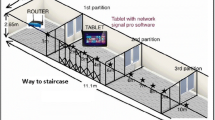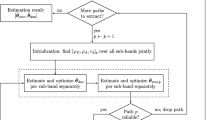Abstract
The realization of the Internet of Things can not be separated from the wireless sensor network which was the extension of communication and perception. The shortage of spectrum resources will become one of the bottlenecks that hinder the rapid development of Internet of Things. A large number of sensor communication makes the interference problem of wireless channel more and more serious. Therefore, the research of wireless channel characteristics and model was important for development of Internet of Things. In this paper, the time domain multipath propagation characteristics of direct, reflection, diffraction and transmission were introduced, which provided a more accurate basis for the design of indoor short distance Ultra-wideband (UWB) communication model. Considering the practicability of simulation, the multipath propagation characteristics of UWB signals under indoor short distance environment with wooden furniture were studied. Moreover, Aluminium door partitions, glass partitions, and plastic furnitures were also considered during our simulation. Based on the time domain ray tracing method, the UWB signal propagation characteristics such as received power distribution, root mean square delay spread, multipath arrive delay distribution parameters were also discussed under line-of-sight and non-line-of-sight propagation. The analysis results provided deployment basis of UWB signal under the indoor environment, which benefit to research and develop technology for indoor Internet of Things.

















Similar content being viewed by others
References
Shen, J., Chang, S.H., Shen, J., Liu, Q., Sun, X.M.: A lightweight multi-layer authentication protocol for wireless body area networks. Future Gener. Comput. Syst. (2016). https://doi.org/10.1016/j.future.2016.11.033
Stojkoska, B.L.R., Trivodaliev, K.V.: A review of Internet of Things for smart home: challenges and solutions. J. Clean. Prod. 140(3), 1454–1464 (2017)
Wang, B.W., Gu, X.D., Ma, L., Yan, S.S.: Temperature error correction based on BP neural network in meteorological WSN. Int. J. Sens. Netw. 23(4), 265–278 (2017)
Yuan, C.S., Sun, X.M., Lv, R.: Fingerprint liveness detection based on multi-scale LPQ and PCA. China Commun. 13(7), 60–65 (2016)
Kshetri, N.: The evolution of the Internet of Things industry and market in China: an interplay of institutions, demands and supply. Telecommun. Policy 41(1), 49–67 (2017)
Tian, Q., Chen, S.C.: Cross-heterogeneous-database age estimation through correlation representation learning. Neurocomputing 238, 286–295 (2017)
Zhang, Y., Liu, G., Tan, L.: Theoretical research on the time delay and corresponding issues for the novel category of internet of things control system. Int. J. Future Gener. Commun. Netw. 9(10), 1–16 (2016)
Rahman, W.F.W.A., Hashim, A.H.A., Islam, M.R.: Security aspects and efforts towards secure Internet of Things. J. Telecommun. Electron. Comput. Eng. 9(2), 147–152 (2017)
Kaupins, G., Coco, M.: Perceptions of Internet-of-Things surveillance by human resource managers. SAM Adv. Manag. J. 82(2), 53 (2017)
Bughin, J., Chui, M.: The Internet of Things: assessing its potential and identifying the enablers needed to capture the opportunity. In: The Internet of Things in the Modern Business Environment, vol. 6, pp. 111–125. IGI Global (2017)
Zhang, J., Tang, J., Wang, T.B., Chen, F.: Energy-efficient data-gathering rendezvous algorithms with mobile sinks for wireless sensor networks. Int. J. Sens. Netw. 23(4), 248–257 (2017)
Qu, Z.G., John, K., Sebastian, R., Faisal, Z., Wang, X.J.: Multilevel pattern mining architecture for automatic network monitoring in heterogeneous wireless communication networks. China Commun. 13(7), 108–116 (2016)
Aburukba, R., Al-Ali, A.R., Kandil, N.: Configurable ZigBee-based control system for people with multiple disabilities in smart homes. In: Industrial Informatics and Computer Systems (CIICS), 2016 International Conference on, pp. 1–5. IEEE (2016)
Idris, Y., Muhammad, N.A.: A comparative study of wireless communication protocols: Zigbee vs Bluetooth. Int. J. Eng. Sci. 6(4), 3741–3744 (2016)
Kim, Y., Lee, S.S., Lee, S.K.: Coexistence of ZigBee-based WBAN and WiFi for health telemonitoring systems. IEEE Trans. Inf. Technol. B 20(1), 222–230 (2016)
Bahrami, H., Mirbozorgi, S.A., Ameli, R.: Flexible, polarization-diverse UWB antennas for implantable neural recording systems. IEEE Trans. Biomed. Circuits Syst. 10(1), 38–48 (2016)
Nikolaou, S., Abbasi, M.A.B.: Design and development of a compact UWB monopole antenna with easily-controllable return loss. IEEE Trans. Antenn. Propag. 65(4), 2063–2067 (2017)
Zhu, J., Li, S., Feng, B.: Compact dual-polarized UWB quasi-self-complementary MIMO/diversity antenna with band-rejection capability. IEEE Antennas Wirel. Propag. Lett. 15, 905–908 (2016)
Zhang, S., Pedersen, G.F.: Mutual coupling reduction for UWB MIMO antennas with a wideband neutralization line. IEEE Antennas Wirel. Propag. Lett. 15, 166–169 (2016)
Poffelie, L.A.Y., Soh, P.J., Yan, S.: A high-fidelity all-textile UWB antenna with low back radiation for off-body WBAN applications. IEEE Trans. Antennas Propag. Lett. 64(2), 757–760 (2016)
Compagno, A., Conti, M., D’Amico, A.A.: Modeling enlargement attacks against UWB distance bounding protocols. IEEE Trans. Inf. Foren. Secur. 11(7), 1565–1577 (2016)
De, A.G., Moschitta, A., Carbone, P.: Positioning techniques in indoor environments based on stochastic modeling of UWB round-trip-time measurements. IEEE Trans. Intell. Transp. Syst. 17(8), 2272–2281 (2016)
Chen, Z., Liu, Y., Li, S.: Study on the multipath propagation characteristics of UWB signal for indoor lab environments. In: Ubiquitous Wireless Broadband (ICUWB), 2016 IEEE International Conference on, pp. 1–4. IEEE (2016)
Shaman, H.N., Almughamis, A.M., Alamro, A.M.: Compact ultra-wideband (UWB) bandpass filter with wideband harmonic suppression. In: Microwave, Radar and Wireless Communications (MIKON), 2016 21st International Conference on. IEEE, pp. 1–4 (2016)
Yao, R., Gao, G., Chen, Z.: UWB multipath channel model based on time-domain UTD technique. In: Global Telecommunications Conference, 2003. GLOBECOM’03. IEEE, pp. 1205–1210. IEEE (2003)
Chen, Z., Yao, R., Guo, Z.: The characteristics of UWB signal transmitting through a lossy dielectric slab. In: Vehicular Technology Conference, 2004. VTC2004-Fall. 2004 IEEE 60th, pp. 134–138. IEEE (2004)
Rappaport, T.S.: Wireless communications: principles and practice, p. 90. Prentice Hall PTR, Upper Saddle River (1996)
Acknowledgement
This work was supported by the National Natural Science Foundation of China under Grant Nos. 51577046, 51704089, 51777050 and 51607004, the State Key Program of National Natural Science Foundation of China under Grant No. 51637004, the National Key Research and Development Plan “Important Scientific Instruments and Equipment Development” Grant No. 2016YFF0102200, Natural Science Foundation of Anhui Province No. 1508085MF112, Natural Science Foundation of Hunan Province No. 2017JJ2080, Basic Research Service Fee Project of Central University No. JDK16TD01, and Equipment research project in advance Grant No. 41402040301.
Author information
Authors and Affiliations
Corresponding authors
Rights and permissions
About this article
Cite this article
Shi, G., He, Y., Li, B. et al. Construction and analysis of multi-path propagation model for indoor short range Ultra-wideband signal based on time domain ray tracing method. Cluster Comput 22 (Suppl 4), 9525–9542 (2019). https://doi.org/10.1007/s10586-018-2487-2
Received:
Revised:
Accepted:
Published:
Issue Date:
DOI: https://doi.org/10.1007/s10586-018-2487-2




